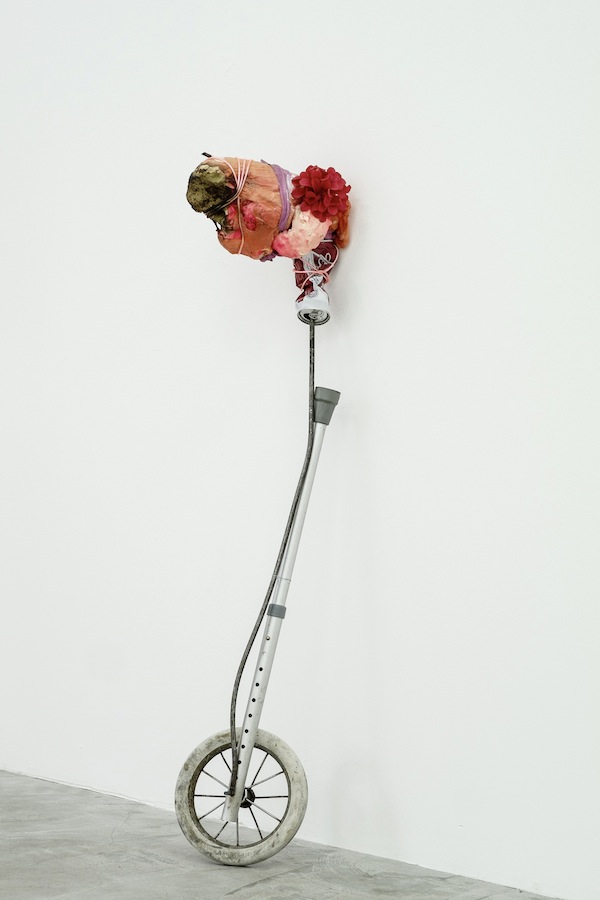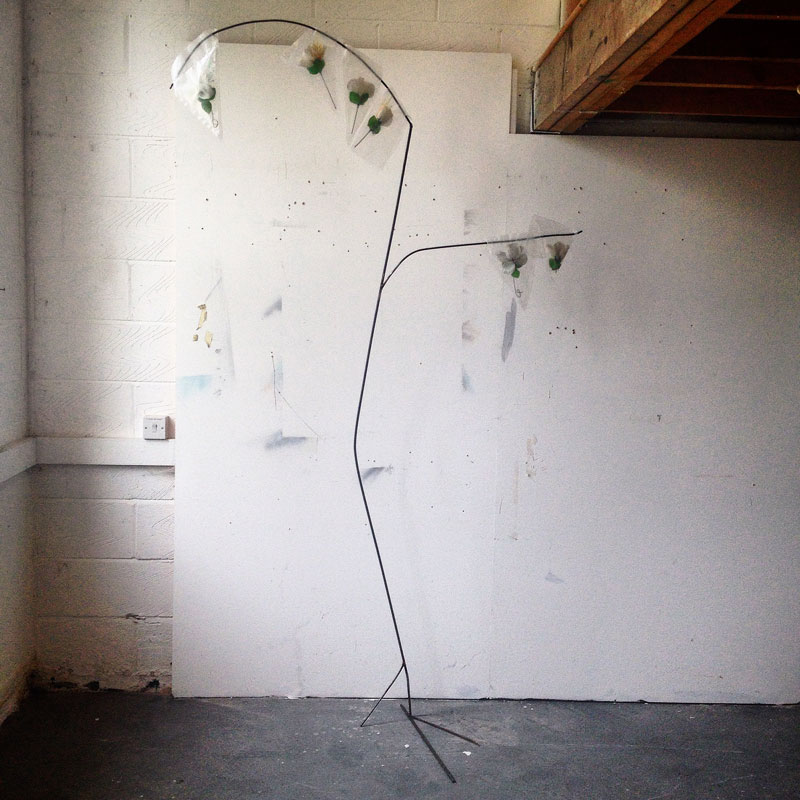
Princess Horse (Tiril’s Horse), Jesse Darling (2015).
QUEERATING
by Binghao Wong.
Out of curiosity, I recently looked up the etymologies of two words that hold increasing significance in both my personal and professional lives: queer (from the German quer, meaning oblique, adverse) and curate (from the Latin cur(a), meaning care). As a queer-identified curator, how do I care for, work with, and remain accountable to queer artists, given that our bodies are all irrevocably outlawed? While disenfranchisement often acts as our morbidly unique binding agent, I began to think about the ways that queer bodies can also contribute to convalescing circuits. Rather than coming together only in times of grief, it should remain our existential imperative to laugh and heal in deviant solidarity.
In heteronormative time and space, queer bodies appear estranged, outlandish, and wayward. Sara Ahmed poetically proposes that a queer phenomenology unveils another way out; an unlikely means to “support” our failed, ostracized bodies. Of the lonely lover, Barthes writes: “I can be understood by everyone, but I can be heard only by subjects who have exactly and right now the same language I have.” It is no coincidence when the queer paths of curator and artist cross: we empathize with each other because and in spite of our particular impediments.
By channeling our pains toward collective care rather than further vitriol, our refractive valences enable us to perform ecologies of halcyon belonging, characterized as much by utopia as they are by abjection. The queer fantasy wouldn’t be perfect without imperfection. Our peculiar form of care is paradoxically contingent on debility and sacrifice, as lived realities unhinge the smoothness of recovery. The skeletal organicity of London-based artist Jesse Darling’s Hubristic Idea of a Tree (2015) parallels the errata of queer care and its representations. Hanging sparsely off bare steel branches are discarded flowers that the artist chanced upon outside a cemetery. In an almost neurotic gesture, they protected the scavenged flowers in plastic pockets. Rescued from oblivion, flowers that were once mnemonic devices for the deceased have now themselves been re/membered by Darling. A forgotten elegy is re-visited, lending its tragedy towards a renewed poetics of representation.
Routinizing love and care doesn’t preclude spectacle: queers are able to perform their banalities, failures, and iridescences concurrently. This radical refusal of compartmentalization opens us up to a plethora of agonistic representations that complement and antagonize each other in unpredictable fashion. When transcribed onto formalism, the politics of queer unknowability can cohere seemingly irreconcilable materials, but only in the most demented ways. Darling practises these strategically perplexing unities through works such as It/Us (2015), a tree-like assemblage of contradictory materials from barbed wire to expanding foam. Misshapen, the foam nodules adorn Darling’s steel structure with nuclear greens and crimsons, taking on a macabre animacy amidst metallic fatality. One particular piece of foam appears to have its growth stunted by piercing wire that has snaked threateningly around it. Here, luminescence is readily curtailed precisely because it thrives explicitly.
Moreover, the individual materials possess inherent paradoxes. Although expanding foam fills gaps and crevices, appearing to make things whole again, it also suffocates and “choke[s] out space.” Foam’s porosity breathes new life into structures, but does so at the expense of other vitalities. Another work, Princess Horse (Tiril’s Horse) (2015), boasts a grotesque anthropomorphic head made from garbage and leftovers. Yet, Darling’s delicate placement of red flowers on the head retrieves a sense of play and innocence from a seemingly ruined figure. The unwieldy head balances precariously on a makeshift unicycle of sorts, made from a single pram wheel and crutch. In Darling’s works, structures of support are demonized, re-worked to retain only the barest semblance of their original salubrious functions, reflecting the inescapable complications of queer life.

The hubristic idea of a tree, Jesse Darling (2015). Courtesy the artist.
Against the supremacy of white heteropatriarchal exceptionalism, queers of colour are singled out and ruthlessly pitted against one another. In this ring of atomistic cultural capitalism, loneliness is competitive sport, another guise for fatality. Queer gatherings must therefore be mobilized as sites of intentional retaliation. We must come together, whether as a riotous mob in the face of legislative and police brutality, or in the coziness of disheveled domesticity. Grounded in humour and pathos, healthy friendships and intergenerational mentorship form vital basal units of socially constructed queer kinship. If collaboration and collectivity are imperatives that strengthen our chosen queer families, how can we begin to practice togetherness in our cultural work?
The arduousness of caring for dejected subjects is an onerous responsibility. Armed with socio-personal burdens, queer communities often do not blend mellifluously. But it is precisely this frictive, idiosyncratic presence that culminates in our radical plurality. While philosopher Jean-Luc Nancy proposes that “being cannot be anything but being-with-one-another,” he also notes that this closeness is always conditioned by isolation and distance. Intimacy is both terminated and fuelled by estrangement.
Queer care is difficult and disconcerting. Darling and fellow London-based artist, Takeshi Shiomitsu, enact these tensions through their collaborations. Spirit Level (2015), a recent exhibition of their joint efforts, falsely hints at a sense of balance and serenity. The prominent use of amenities, medicines, and alimentary goods also points to the maintenance of a collective, domestic life. But akin to Darling’s individual practice, dis-ease is always implicated within comfort. Saccharine pink boxing bags take centre-stage in the exhibition space, anticipating the uninhibited violence of what appear to be holes punched into framed surfaces. In the confusing aftermath of the duo’s apocalyptic love, the prevalence of preservative materials like plastic bags, foam, and tape seems futile. Still, Darling and Shiomitsu’s counter-intuitive, almost desperate, impulse to repair the irreparable invokes the foremost contradiction of queer care: it revels in the fault-lines of rationality.
By prioritizing practice over theory, we expose ourselves to the vicissitudes and irreconcilable particularities that come with the pragmatics of queerating. Mutual sharing of anecdotes, genealogies, and desires are essential to processual learning. Once incorporated into curatorial work, these interpersonal revelations of urgent (yet untold) stories more often than not result in significant paradigm shifts. Curating-as-method derives its interest paradoxically because it is a volatile and intensely personal experience.

Installation view of Spirit Level, AND/OR, photo by Tom Carter, courtesy Jesse Darling & Takeshi Shiomitsu
Binghao Wong is a curator, writer, and killjoy. He thinks about critically pluralizing the theories and representations of queer life. Curatorial projects include WE ARE LOSING INERTIA (2014) and Asymmetric Grief (2015).